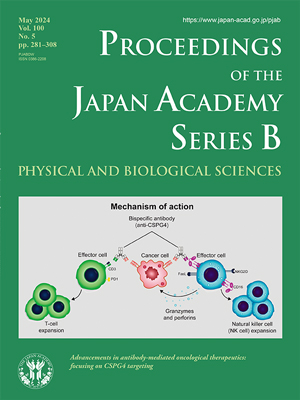About the Cover
Vol. 100 No. 5 (2024)
Cancer therapy continues to face significant challenges in striking an optimal balance between therapeutic efficacy and toxicity. Conventional modalities such as chemotherapy and radiation therapy indiscriminately target both malignant and healthy cells, often leading to severe adverse effects. Antibody-based therapies, leveraging the exquisite specificity of antibodies, have emerged as a promising approach to selectively recognize and eliminate target cells while minimizing collateral damage to normal tissues.
In this context, chondroitin sulfate proteoglycan 4 (CSPG4), a tumor-associated antigen identified by Dr. Kohzoh Imai and Dr. Soldano Ferrone et al., in the late 1980s, has garnered significant attention. CSPG4 is overexpressed in various refractory malignancies, including melanoma, triple-negative breast cancer, and mesothelioma, while exhibiting limited expression in most normal tissues. This proteoglycan plays a pivotal role in tumor growth, invasion, metastasis, and drug resistance, rendering it an attractive therapeutic target. See the review article in this issue by Kurokawa and Imai, pp. 293–308.
This figure on the front cover is a schematic of a bispecific antibody, one of the most advanced antibody-based anticancer therapies described in their review. These innovative molecules comprise two antibody fragments, one specifically binding to the antigen on cancer cells and the other recognizing a target molecule on effector cells such as T cells or natural killer cells. This dual specificity facilitates the formation of an immunological synapse, bridging cancer antigen-positive tumor cells and effector immune cells, thereby inducing potent cytotoxic responses against the malignant cells.
Numerous preclinical studies have demonstrated the remarkable antitumor efficacy of cancer antigen-targeted bispecific antibodies, exhibiting dramatic cytotoxic activity against cancer cell lines and patient-derived xenograft models. Depending on their design, these bispecific antibodies can also promote the infiltration of effector cells into the immunosuppressive tumor microenvironment, potentially synergizing with existing immune checkpoint inhibitors.
Several challenges remain, because CSPG4 exhibits low-level expression in certain normal tissues; therefore, ensuring target specificity and minimizing associated toxicities is crucial. Additionally, strategies to combat acquired resistance mechanisms and CSPG4 antigen loss during prolonged treatment are imperative. Consequently, the establishment of multi-modal approaches combining various mechanisms of action is highly desirable.
Driven by the pioneering work of Dr. Imai, Dr. Ferrone, and others, the development of CSPG4-targeted therapies has gained significant momentum. Several CSPG4-targeting bispecific antibodies are currently undergoing clinical evaluation for various refractory malignancies, with great anticipation for improving treatment outcomes.
Although challenges persist, the identification of CSPG4 as a promising therapeutic target and the advent of bispecific antibody technology and others represent significant strides in the quest for more effective and safer cancer therapies, offering hope for improved patient outcomes and quality of life.
Yoshiaki Kanemoto, MD, PhD
Project Lecturer, Faculty of Pharmacy, Iryo Sosei University
Department of Surgery, Jyoban Hospital of Tokiwa Foundation




